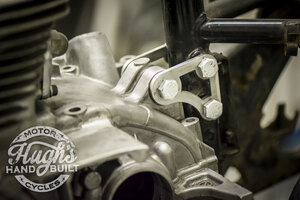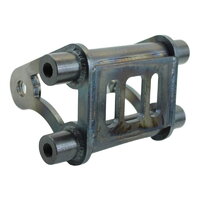Well I was listening to some tunes and must have been driven subliminally toward this posting.
A topic I have been considering for some time.
The vibration encountered on these machines borders on legendary. There have been numerous posting in this regard about the various countermeasures that members have utilized in an effort to reduce the effects and severity of said vibrations. I am not looking to rehash those solutions, nor am I looking for yet another evaluation of their effectiveness.
These solutions would include and are not limited to...:
Rubber isolators on the handlebar risers
Stuffing the handlebars with various materials.
Rephasing
I would like the direction and focus of this thread to center around isolating the source of the vibration (the motor).
Isolating motor mounts have been the standard for vibration reduction forever within the automotive industry. They are also commonly utilized in industrial applications with drive motors in some applications.
There are some examples within the motorcycle industry as well. The xs650 was designed with solid mounts which transfer close to 100% of the vibration to the frame and thus the rider.
It appears from a cursory look at the motor mounts that they could be modified from either of the attachments points (motor or frame side).
The rubber isolater that would be sandwiched between the frame and the mount appear to be commonly available and faily cheap.
I am curious whether anyone has any experience attempting what seems like a potentially simple solution to this issue. It is my thinking that solutions are generally more effective when they can be applied directly to the problems causation. I haven't seen this discussed with any specificity. I am interested in other members viewpoints, opinions, experiences, or thoughts in general. I know that I will be making an attempt at some point to implement this idea.
A topic I have been considering for some time.
The vibration encountered on these machines borders on legendary. There have been numerous posting in this regard about the various countermeasures that members have utilized in an effort to reduce the effects and severity of said vibrations. I am not looking to rehash those solutions, nor am I looking for yet another evaluation of their effectiveness.
These solutions would include and are not limited to...:
Rubber isolators on the handlebar risers
Stuffing the handlebars with various materials.
Rephasing
I would like the direction and focus of this thread to center around isolating the source of the vibration (the motor).
Isolating motor mounts have been the standard for vibration reduction forever within the automotive industry. They are also commonly utilized in industrial applications with drive motors in some applications.
There are some examples within the motorcycle industry as well. The xs650 was designed with solid mounts which transfer close to 100% of the vibration to the frame and thus the rider.
It appears from a cursory look at the motor mounts that they could be modified from either of the attachments points (motor or frame side).
The rubber isolater that would be sandwiched between the frame and the mount appear to be commonly available and faily cheap.
I am curious whether anyone has any experience attempting what seems like a potentially simple solution to this issue. It is my thinking that solutions are generally more effective when they can be applied directly to the problems causation. I haven't seen this discussed with any specificity. I am interested in other members viewpoints, opinions, experiences, or thoughts in general. I know that I will be making an attempt at some point to implement this idea.



